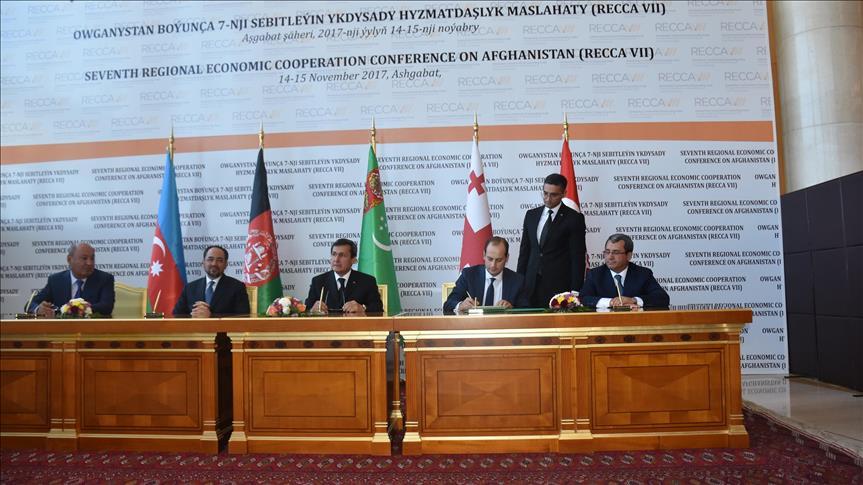China Funded Lapis-Lazuli Transport Corridor Unites Caucasus and Central Asia


The Lapis Lazuli Corridor Agreement Being Signed In Ashgabat
China’s reach into Central Asia and the Caucasus has taken a major step forward with a new initiative poetically known as “The Lapis-Lazuli Transit, Trade & Transport Route” (or the “Lapis Lazuli Corridor”). This aims to enhance regional economic cooperation and connectivity between Afghanistan, Turkmenistan, Azerbaijan, Georgia, and Turkey, and according to the Chinese and regional governments concerned, will expand economic and cultural links between Europe and Asia. In doing so, the initiative seeks to improve transport infrastructure and procedures (including for road, rail, and sea), increase exports, and expand the economic opportunities of the countries benefiting from this new transport corridor.
Afghanistan, Turkmenistan, Azerbaijan, Georgia, and Turkey signed an agreement last month on the creation of the Lapis Lazuli transport corridor, which is set to connect the five countries. The document, which was finalized after three years of technical talks, was signed on the margins of the 7th Regional Economic Cooperation Conference on Afghanistan (RECCA) in Ashgabat on November 15.
The project is unusual and in some part politically sensitive because it is largely based on existing supply chains paid for by the US military to support the war in Afghanistan following 9/11. While the conflict against the Taliban is still on-going, it is not to the same level of intensity as before, hence, the availability of the route for commercial purposes and it being turned over to regional governments to utilize as a trade and connectivity platform from the heart of Afghanistan to the borders of Europe.
There are financial and regulatory reforms going hand in hand with this. New trade, transit, and transaction costs will be reduced, in part, through a new Custom Integration Procedure between Afghanistan and Turkmenistan, in addition to a new Cross-Border Transport Agreement. Its projected impact is considerable not only because most of the required infrastructure is already in place, but also because most of the investment required will focus on improving policy and governance. The Economic Rate of Return and Net Present Value still needs to be established, but with a discount rate applied at 12 percent, the overall returns are expected to be positive. The Lapis Lazuli Corridor will connect with Turkey’s Middle Corridor Project (“East-West Trans-Caspian Trade and Transport Corridor”).
The corridor begins from Afghanistan’s Aqina City in northern Faryab province and Torghundi City in western Herat, both of which are situated close to the Afghani border with Turkmenistan. Crucially, both Aqina and Torghundi have rail connectivity through to Turkmenistan. From there, the routes continue west to the Caspian Sea Port of Turkmenbashi, in Turkmenistan. After transiting the Caspian, the route continues on to Baku, capital of Azerbaijan, and then connects onward to Tblisi, capital of Georgia, as well as the Georgian ports of Poti and Batumi; finally, the corridor will connect to the cities of Kars and Istanbul in Turkey, at the gates of Europe.
The name “Lapis Lazuli” is derived from the historic route that Afghanistan’s lapis lazuli and other semi-precious stones were exported along, over 2,000 years ago, to the Caucasus, Russia, the Balkans, Europe, and North Africa.

Discussions concerning logistics operations of the route are still in progress. However, the associated feasibility studies, consideration of the project’s long-term infrastructure maintenance (O&M), and financing have all been sourced for the corridor’s related infrastructure requirements.
Major actions needed to complete the route include: 1) improvement of road conditions and transit facilities along major highways; 2) expansion of rail links between Afghanistan and Turkey and beyond; 3) improvement of multi-modal land ports in each of the five Lapis Lazuli Corridor countries; and 4) Cost-Benefit Analysis on establishing Cross-Border Economic (Tax Free) Zones between the countries along the corridor.
Sewing such a tax free deal together though would prove a challenge, and likely involve in some form the Eurasian Economic Union and Commonwealth of Independent States .Turkey has expressed an interest in having a Free Trade Agreement with the Eurasian Economic Union, while Turkmenistan is an associate member of the CIS as is Azerbaijan. Georgia withdrew as a member of the CIS following the Russia-Georgia border war in 2008, and regional rivalries and issues with Russia would be hard to solve without support from Moscow. China, however, which is also pursuing a Free Trade Agreement with the Eurasian Economic Union, may also be influential. Keeping both Beijing and Moscow at arms length may also suit the Lapis Lazuli nations, who could agree their own customs and trade tariff regulations along the route.
There are additional complexities, not least being the security situation in Afghanistan, but also American strategic interests along almost the entire corridor. China, especially, has been somewhat reluctant to publicly acknowledge the route as being part of its Belt and Road initiative, although it is providing both finance and construction teams and materials to help develop and upgrade the route.
Current project estimates exceed US$2 billion, while Institutional Partners include China (via the Bank of China), the Kyrgyz Republic, Tajikistan, Afghanistan, Iran, Turkey (including its Foreign Economic Relations Board), the Asia Development Bank, the World Bank, and the United States. Products can be expected to be mainly agricultural based, electronics and plastic items, as well as hand made expensive items such as carpets, other fabrics such as cottons, chemicals, and indeed, lapis lazuli. Afghanistan still produces much of the world’s supply of the stone, which is used in jewelry, expensive paints, and dyes.
About Us
Silk Road Briefing is produced and written by Dezan Shira & Associates. The firm provides governments and corporate businesses worldwide with strategic, legal, tax and operational advisory services to their SMEs and MNCs investing throughout Eurasia and has 28 offices across China, India, Russia and the ASEAN nations, and partner firms in Central Asia. We have specific and long term experience in China and the OBOR countries. For assistance with OBOR related issues, please contact the firm at silkroad@dezshira.com or visit the practice at www.dezshira.com
 Related Reading:
Related Reading:
![]() Understanding China’s Free Trade Agreements Along The OBOR Routes
Understanding China’s Free Trade Agreements Along The OBOR Routes
Silk Road and OBOR Business Intelligence
Dezan Shira & Associates´ Silk Road and OBOR investment brochure offers an introduction to the region and an overview of the services provided by the firm. It is Dezan Shira´s mission to guide investors through the Silk Road´s complex regulatory environment and assist with all aspects of establishing, maintaining and growing business operations in the region.
China’s New Economic Silk Road
This unique and currently only available study into the proposed Silk Road Economic Belt examines the institutional, financial and infrastructure projects that are currently underway and in the planning stage across the entire region. Covering over 60 countries, this book explores the regional reforms, potential problems, opportunities and longer term impact that the Silk Road will have upon Asia, Africa, the Middle East, Europe and the United States.







